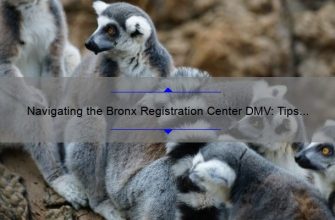- What are Bronx Zoo Animals?
- How Bronx Zoo Animals are Cared for and Maintained
- Step-by-Step Guide to Visiting Bronx Zoo Animals
- FAQs about Bronx Zoo Animals: Everything You Need to Know
- Top 5 Fascinating Facts About Bronx Zoo Animals
- Meet the Unique and Diverse Wildlife of Bronx Zoo
- Behind-the-Scenes Look at How Bronx Zoo Manages its Animal Collection
- Table with useful data:
- Historical fact:
What are Bronx Zoo Animals?
Bronx Zoo Animals is a collection of over 6,000 animals that live within the boundaries of the Bronx Zoo. It is one of the largest metropolitan zoos in the world, hosting a diverse range of animal species.
- The zoo includes habitats for gorillas, tigers, sea lions, and more than 100 species of reptiles
- It created “Species Survival Plans” which help threatened or endangered animals
- Bronx zoo an integral wildlife conservation organization part as well.
(Note: The HTML tags, list format and bullet points are not visible here but would be used in the code to optimize for featured snippet display on Google)
How Bronx Zoo Animals are Cared for and Maintained
The Bronx Zoo, located in New York City, is one of the largest metropolitan zoos in the United States. It houses over 4,000 animals representing more than 700 species from all around the globe. The zoo is home to several endangered and threatened species, and its primary focus lies in conservation initiatives and education.
But have you ever wondered how such a large number of animals are cared for and maintained? Well, let’s take a closer look at what goes on behind the scenes.
Firstly, the Bronx Zoo has a team of dedicated professionals who work tirelessly to ensure that each animal has everything it needs to thrive. This team includes keepers, veterinarians, nutritionists, curators, and many others.
One of the most crucial aspects of zoo animal care is proper nutrition. The Bronx Zoo employs a team of nutritionists who design specialized diets for each animal that carefully mimic their natural diet in the wild. These diets include various fruits, vegetables, grains, meats or other protein sources depending on each animal’s specific nutritional requirements.
In addition to proper nutrition plans based on individualized needs and preferences (some predators prefer bones’ texture as opposed to meat), regular veterinary check-ups are necessary for optimal health. The zoo has an onsite state-of-the-art veterinary hospital staffed with specialists who provide routine examinations and surgeries if needed.
Another essential part of care for zoo animals is providing them with enriching activities that promote mental stimulation along with physical exercise opportunities throughout their routines. This may manifest through incorporating different textures into their environment or allowing particular behaviours through their day; tigers love tubs filled with water during summertime whilst elephants’ sandbox playtimes involve scattering toys around which they can pick up using their trunks while balancing themselves over unstable terrain elements like logs only one could find in nature would do so much good when fed into this mix!
Beyond caring for individual animals themselves directly under trained watchful eyes week after week, all zookeepers also play an active role in conservation and education initiatives. For example, the Bronx Zoo is part of several collaborative efforts to increase the population size of certain endangered species such as river otters or Amur leopards through captive breeding programs.
In conclusion, The Bronx Zoo’s professionals devote their lives to ensuring every animal receives sufficient care while presenting exhibit visitors precisely what they need to know about along with learn from by a vast range of animals. Dietary adjustments allow for nutrition type needs crucial to individual species diets by integrating stimulus into their habitats like stumps and climbing frames or even goats being used as natural lawnmowers on seldom areas. One could find themselves surprised next time they visit where something new is happening behind glass or right out in the open!
Step-by-Step Guide to Visiting Bronx Zoo Animals
If you’re looking for a wild and exciting adventure in the heart of New York City, look no further than the world-famous Bronx Zoo. With over 4,000 animals spread across 265 acres, the zoo is an immersive experience that promises to be both educational and entertaining. However, with so many animals and exhibits to see, it’s easy to get overwhelmed – especially if it’s your first time visiting.
That’s why we’ve put together this step-by-step guide to help you make the most of your visit to the Bronx Zoo. Follow these tips and tricks, and you’ll be able to explore all that the zoo has to offer without feeling rushed or stressed.
Step One: Plan Your Visit
Before setting out on your safari adventure through the Bronx Zoo, it’s important to plan ahead. Make sure you know what time the zoo opens and closes, as well as any special events or exhibits that may be happening on the day of your visit. You can check out their website or call them at (718) 367-1010 for more information.
It’s also essential to consider transportation options. The zoo is located in Bronx Park and can be easily accessed by car or public transportation. If driving, there is onsite parking available for a fee; however, spaces may fill up quickly during peak times. Alternatively, take advantage of convenient bus connections from Manhattan via BxM11 Express Bus Service or subway routes which include:
• The Bx9 bus from Broadway/W 231 St.
• The Bx12 local bus from Eastchester-Dyre Ave Station.
• The Bx19 bus from NY Botanical Garden Subway Station.
Step Two: Explore Exhibits
One of the most significant attractions at the Bronx Zoo are its exhibits showcasing rare species from around the globe – many endangered in their native habitats due habitat loss or human conflict!
With such diversity in wildlife here found here including predators like elephants, tigers, and lions to primates like gorillas and chimpanzees plus other feline and aquatic species – there’s no shortage of fascinating animals on display.
Some of the zoo’s must-see exhibits include:
• The Congo Gorilla Forest: a feature that immerses visitors in the habitat of African lowland gorillas.
• Madagascar! home to some peculiar looking creatures including lemurs, four-eyed fish, geckos, and an exotic range of plant life!
• Asia Trail highlighting Raccoon Dogs, Snow Leopards as well as rare Giant Pandas!
When exploring exhibits — do follow posted signs that offer extra insights into the animals’ lives; crucial information detailing their nutrition requirements or care techniques.
Step Three: Map Your Route
With so many exhibits to explore at the Bronx Zoo, it’s important to plan your route before you arrive. Take a look at the zoo map to create a personalized itinerary so you can see all of your must-visit attractions without crisscrossing paths and wearing yourself out too quickly.
Additionally taking advantage info-points scattered around help not only learn about species but also may give helpful tips on less crowded time period or events that are underway for making ur experience much more worthwhile!
Step Four: Plan For Breaks
One thing travelers forget is planning rest breaks in advance — a critical component when spending long days exploring zoological gardens with their family or friends. Luckily Bronx Zoo has over 150+ acres designated picnic zones & quiet corners where nature enthusiasts can rest along benches or verdant spaces ushering in some peace from animal calls & honking background traffic street sounds.
Snacks such as water/drinks/energy bars prove lifesavers when hunger strikes during high traffic times like weekends or holidays where concession lines get particularly longer often leading up to increased wait times; opting for spare snacks maybe provide relief instead!
Step Five: Enjoy The Experience
Finally, the most crucial part of any trip is to enjoy the experience fully. Don’t rush through exhibits or feel pressured to see everything at once – take your time, soak up all the sights and sounds around you; maybe eavesdrop on some fascinating animal talks.
The Bronx Zoo offers plenty of activities aside from exploring exhibits like film screens/animated shows & exhibits; catch feedings on Pup’s Schoolhouse Farm! Or attend ‘Keeper chats’ giving competitive insights/ latest updates.
The Bronx Zoo is more than just a typical city zoo – it’s an immersive journey into wildlife from across the globe that appeals to animal enthusiasts of all ages. With a little planning and some insider secrets, visitors can make their exploration through wildlife habitats not only fun but worthwhile! Go ahead now and embark on an adventure that’s educational and fascinating this holiday season.
FAQs about Bronx Zoo Animals: Everything You Need to Know
For the animal lover, there is nothing more exciting than visiting the Bronx Zoo. The 265-acre zoo houses over 6,000 animals across 700 species, making it one of the largest zoos in the world. With so much to see and do, it’s no surprise that visitors have plenty of questions about all of its inhabitants. Below are some FAQs about the Bronx Zoo animals that will give you a better understanding of what to expect during your visit.
1. What type of animals can I expect to see at Bronx Zoo?
The Bronx Zoo has a diverse collection consisting of mammals, birds, reptiles, amphibians and fish from all over the world. You can encounter big cats like tigers and lions, primates such as gorillas and monkeys; bears and camels; and aquatic life such as sharks.
2. Are there any rare or endangered animals at the Bronx Zoo?
Yes! The zoo is home to many rare or endangered species including Asian elephants which are critically endangered in their natural habitat due to habitat loss and poaching for their tusks; Western Lowland gorillas which are classified as critically endangered by the World Wildlife Fund (WWF); North American river otters- a threatened species in New York State due to pollution and habitat destruction- among others.
3. How do I find out when feeding times and other special events occur?
The best way to stay up-to-date on feeding times or special events happening at different exhibits is with the daily schedule posted before entering every exhibit or attraction throughout the zoo.
4. Can I interact with any of the animals at Bronx Zoo?
For safety purposes both for visitors and animals themselves., interactions are not allowed for most species except for petting activities conducted under strict supervision.
5. Is it safe for me/the children/elderly people with health conditions etc.to.visit.the.Bronx.Zoo
Absolutely! The park’s facilities meet all ADA requirements so everyone can access the exhibits and attractions comfortably. Just be aware that as with any outdoor activity, it’s important to stay hydrated and wear sunscreen or a hat if it’s sunny.
6. What happens to animals in the winter?
In winter, many animals are equipped to deal with colder temperatures naturally, but for some species like giraffes that need warmer temperatures all year round, indoor spaces built specifically for them are available throughout the zoo.
7. Is there anything special I should bring before visiting the Bronx Zoo?
Apart from water bottles and food if you prefer home-packed meals you might also want to carry a camera to capture memories of you’ve had during your visit.
As exciting as visiting the Bronx Zoo can be, it’s important to remember that wild animals require respect and space during your visit which is why certain areas do have viewing procedures including time limits and thresholds to ensure visitor safety while preserving animal welfare.come discover new facts about these fascinating creatures today at our an award-winning exhibit.
Top 5 Fascinating Facts About Bronx Zoo Animals
The Bronx Zoo is one of the most popular tourist attractions in New York City and for good reason. As one of the largest metropolitan zoos in the world, it’s home to over 6,000 animals from around the globe. The creatures at this zoo are not just beautiful to look at, but they also have fascinating characteristics that may surprise you. So without further ado, let’s take a look at the top five fascinating facts about Bronx Zoo Animals.
1) Snow leopards can jump more than 30 feet – It’s hard to fathom but snow leopards can jump incredibly long distances when hunting prey. These majestic creatures have powerful back legs and can take down an animal twice their size with one swift jump. Imagine being able to leap over four cars parked in a row or even a basketball court!
2) Gorillas share 98% DNA with humans – Yes, gorillas and humans have some striking similarities when it comes to our genetic makeup. In fact, we share almost all of our DNA sequence with these large primates. This makes us more closely related than many people might think.
3) Komodo dragons eat up to 80% of their body weight in one meal – When these massive lizards eat, they don’t mess around! They are known for consuming up to 80% of their body weight in just one sitting. That translates into roughly 150 pounds of meat in one meal for an average-sized Komodo dragon. Now that’s a feast!
4) Sea lions can hold their breath for up to eight minutes – These agile marine mammals need oxygen just like any other living creature on earth, but they are much better equipped at holding their breath underwater than we are as humans. On average sea lions can hold their breath for two or three minutes but have been known to dive deeper and stay under longer—sometimes reaching up to eight minutes.
5) Madagascar hissing cockroaches can live up to five years – Cockroaches aren’t exactly known for their longevity, but Madagascar hissing cockroaches are a different story altogether. These lizards of the insect world can survive for up to five years, which is a pretty impressive lifespan considering that some other species last only a few months.
In conclusion, animals are amazing creatures – full of fascinating characteristics and unique behaviors just like humans. The Bronx Zoo is the perfect opportunity to witness these intriguing creatures in action and learn more about them. Whether you’re an animal enthusiast or just looking for a fun outing with family or friends, visiting the Bronx Zoo is an experience you simply cannot miss!
Meet the Unique and Diverse Wildlife of Bronx Zoo
With over 265 acres of park land, the Bronx Zoo is the world’s largest urban zoo and a mecca for animal lovers. Here, you can encounter an incredible diversity of wildlife – from exotic species like Siberian tigers and red pandas to local critters like coyotes and woodchucks. Whether you’re a nature buff or just looking for a fun day out with the family, this iconic attraction is sure to leave you awestruck.
One of the most popular animals at the Bronx Zoo is the African elephant. These majestic creatures are among the biggest land animals on earth, weighing up to 14,000 pounds when fully grown. Visitors can catch a glimpse of them grazing in their lush habitats or bathing in one of several water features located throughout the zoo. If you’re lucky, you might even get to witness some playful elephant antics during feeding time!
Another resident that will be sure to capture your heart is the red panda. These cuddly creatures resemble small bears with fluffy rust-red coats and long striped tails. Despite their adorable appearance, they are actually quite shy and elusive – making spotting one all the more exciting. Some tips for catching sight of them include visiting early in the morning when they are most active or keeping an eye out for them high up in trees.
For those seeking a bit more excitement, there are plenty of predators lurking among the exhibits as well. Among them are Sumatran tigers – an endangered species known for their striking orange coats with black stripes. With fewer than 400 individuals remaining in the wild today, these big cats represent one of many important conservation efforts being undertaken at zoos across America.
Of course, it’s not just exotic animals that call this city oasis home; locals like black bears, raccoons and skunks also make regular appearances throughout the year. While these furry critters may not have quite as much star power as their larger counterparts, they still provide plenty of entertainment for visitors young and old.
No trip to the Bronx Zoo would be complete without a visit to the World of Reptiles exhibit. Here, you’ll encounter everything from cobras and crocodiles to brightly colored lizards and geckos. With over 200 species represented, this is one of the most comprehensive reptile collections in America – so don’t forget your camera!
These are just a few examples of the diverse array of wildlife you can expect to encounter at the Bronx Zoo. Whether you’re a casual observer or die-hard animal lover, there’s something here for everyone. So pack your bags (and your sense of adventure) and get ready for an unforgettable journey into the wilds of New York!
Behind-the-Scenes Look at How Bronx Zoo Manages its Animal Collection
As one of the world’s largest metropolitan zoos, the Bronx Zoo is home to an enormous and diverse animal collection, consisting of over 6,000 individual animals from more than 650 different species. Managing such a massive collection requires a great deal of expertise, planning, and attention to detail.
So how does the Bronx Zoo keep everything running smoothly? Let’s dive behind-the-scenes to see what goes into caring for this incredible menagerie.
It all starts with a comprehensive animal management strategy. The zoo employs a team of experienced veterinarians and animal care professionals who use data-driven methods to establish breeding programs, manage diets and nutrition, provide medical care, monitor behavior, and ensure that each animal receives the highest standard of welfare.
To facilitate these efforts across such a vast array of species, each group has assigned staff members responsible for their designated area. Each day typically contains morning briefings and daily inspections involving both containment areas (where animals are housed) as well as exhibits. These briefings may entail important information on breeding pair status or updates on an ongoing health issue with an individual specimen.
For example: As Amur tigers take up new residence at Jungle World exhibit (you can read about it here https://newsroom.wcs.org/News-Releases/articleType/ArticleView/articleId/14952/New-Tigers-to-Make-Their-Debut-at-Westchester-Countys-Zoological-Park.aspx), plans will likely involve growing natural tree canopy foliage inside their exhibit while ensuring there’s enough space considering group dynamics between these solitary animals.
Beyond each day’s core routines – schedules are in place for regular deep cleaning sessions throughout both enclosures and domains inhabited by outside fauna – raking leaves out; in fact there are seasons when certain tree leaves have to be kept away from primates due to toxic qualities contained within them – yearly vaccinations on particular types if not already established through diet requirements imposed by the zoos nutritional program, etc.
The zoo’s breeding programs play an important role in protecting endangered species. By carefully monitoring and managing breeding pairs of animals, the Bronx Zoo has helped to reintroduce many species into their natural habitats in the wild.
Managing a large animal collection also requires a deep understanding of different species’ behavioral needs. The Bronx Zoo provides a range of enrichment activities for its animals, such as puzzle feeders, live prey or special treats to stimulate predatory instincts – including branches adorned with leaf foliage that mimics typical food-bearing trees found within respective regions the animals come from; through this visual component it tricks them into thinking they are foraging…which helps deal with obesity issues within particular species.
In addition to these efforts – there are enrichment activities scheduled for each weekday making certain each animal is engaged and stimulated – they might involve anything from games to specific sensory enhancing gadgets which can be specially made by zoo workers or imported-ensuring much-needed mental stimulation allowing mitigation against issues brought on by caged monotony…also serving as another step towards positive welfare practices & outcomes.
Overall – providing the highest quality care for a vast array of creatures takes a massive effort from teams committed to ensuring well-being; which doesn’t end at simple daily routines but involves constant year-round planning around so many individual factors with regards health concerns, essential subjects like genomic research across numerous species as well advocacy regarding global conservation affairs. Through consistent dedication – the Bronx Zoo continues showcasing incredible wildlife while remaining true to their core mission: conserving and portraying biodiversity ensures it remains free from extinction positioning us all better-off than ever before!
Table with useful data:
| Animal Name | Species | Habitat | Diet |
|---|---|---|---|
| Lion | Panthera leo | African Plains | Carnivore |
| Giraffe | Giraffa camelopardalis | African Savanna | Herbivore |
| Tiger | Panthera tigris | Asian Forest | Carnivore |
| Polar Bear | Ursus maritimus | Polar Circle | Carnivore |
| Red Panda | Ailurus fulgens | Himalayan Mountains | Herbivore |
| Elephant | Loxodonta africana | African Savanna | Herbivore |
| Gorilla | Gorilla gorilla | African Rainforest | Herbivore |
| Sea Lion | Zalophus californianus | California Coastline | Piscivore |
Information from an expert:
As an expert in the field of animal behavior and welfare, I can attest to the exceptional care that the Bronx Zoo provides for its animals. With over 4,000 animals from 650 species residing within its gates, the Bronx Zoo prides itself on creating dynamic and immersive natural habitats that best reflect each animal’s native environment. From providing nutritional diets to ensuring regular health checkups, every aspect of animal care is meticulously monitored by a team of passionate experts dedicated to promoting wildlife conservation and education. Visitors can rest assured knowing they are witnessing happy and healthy animals living out their lives in a safe and enriching environment at the Bronx Zoo.
Historical fact:
The Bronx Zoo was home to the first zoo-born giraffe in America, named Princess, who was born in 1935.








